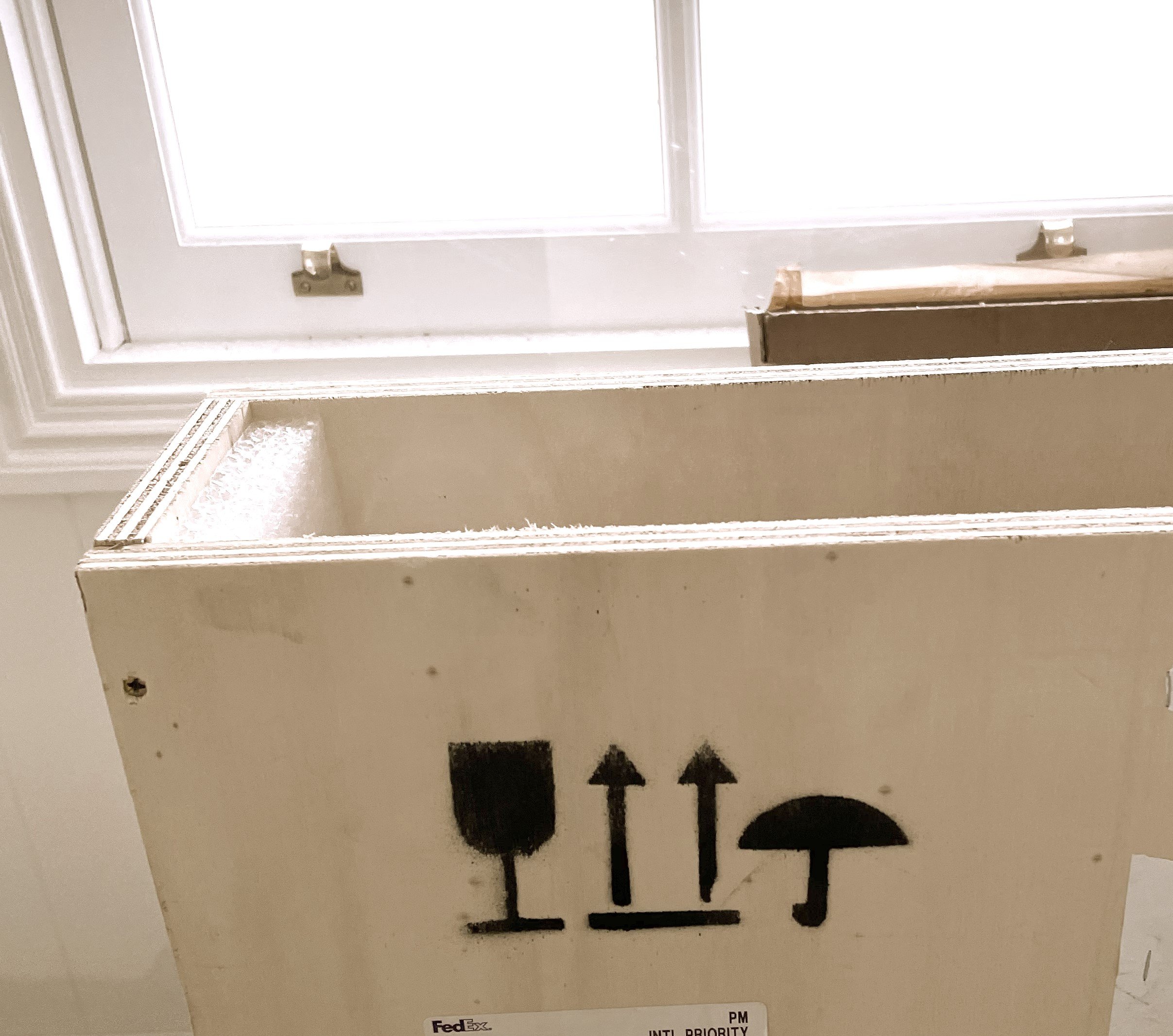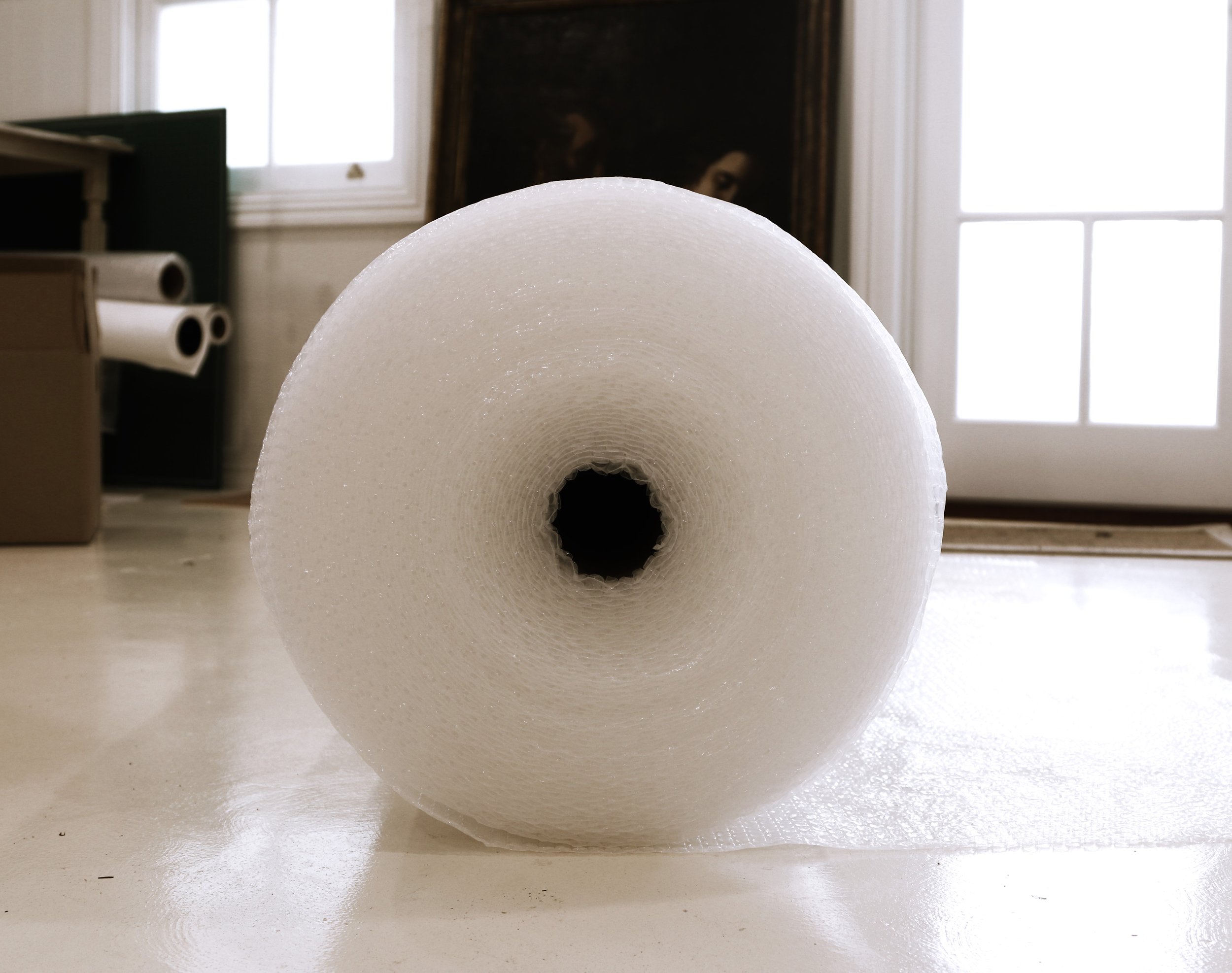
How to Properly Wrap
a Painting for Storage or Transport
As a painting conservator, I am often asked about the best way to wrap artwork for transport or storage. Whether you're moving your artwork to a new location, sending it for an exhibition, or simply storing it away for a while, proper wrapping is essential to avoid damage.
Here’s a step-by-step guide on how to wrap a painting for safe transport or storage.
Materials You Will Need:
Tissue Acid-Free Paper or Glassine Paper – Both tissue acid-free paper and glassine paper are great options for protecting the surface of your painting. Acid-free paper is a safe, neutral option that will not react with the painting over time, making it ideal for long-term storage. Glassine paper, on the other hand, is smooth, moisture-resistant, and more commonly used by conservators for added protection against dirt, dust, and minor abrasion. It’s a great option if you need an extra layer of protection for paintings during transport.
Bubble Wrap – This provides cushioning and impact resistance for your artwork, especially when it’s being transported. Bubble wrap absorbs shocks and helps protect against external impacts. However, avoid wrapping the painting too tightly in bubble wrap as it may put pressure on the artwork.
Plywood Sheets or Cardboard – For added rigidity and protection, plywood sheets provide strong, durable protection against pressure during shipping or long-term storage. If you want a more lightweight and flexible alternative, cardboard can also be used. Plywood offers greater strength and is ideal for paintings that require extra care, while cardboard is a cost-effective and more accessible option for less fragile pieces.
Packing Tape – Use low-stick packing tape to secure the layers of wrapping, ensuring that nothing shifts during transport. Be sure not to tape directly onto the artwork or its protective wrapping, as this can cause damage to the surface.
Corner Protectors – Protecting the delicate corners of the frame is crucial, as these areas are more vulnerable to damage. Corner protectors can be made from foam, cardboard, or other soft materials to cushion and shield the edges from impact.
Stretch Film (Optional) – This is an optional step, but using stretch film can help to hold everything together tightly. It prevents any shifting of the packaging and also offers an additional layer of dust and moisture protection. Be careful not to wrap too tightly as it may cause unnecessary pressure on the painting.



Step-by-Step Guide to Wrapping Your Painting
1. Prepare the Workspace
Find a clean, flat surface to work on, such as a large table or the floor. Lay down a clean cloth or sheet to protect the painting from dust and dirt.
Have all your materials ready: glassine paper or acid-free paper, foam sheets, corner protectors, and plywood or cardboard.
2. Clean the Painting
Gently clean the painting’s surface to remove any dust or debris. Use a soft brush or a lint-free cloth, being careful not to disturb the artwork.
Ensure the frame is also free of dust and dirt.
3. Cover the Painting with Paper
Lay the painting face down on a clean cloth or surface.
Wrap the painting with glassine paper or acid-free paper, ensuring the surface is completely covered. Glassine paper is a smooth, protective option ideal for transport, while acid-free paper is perfect for long-term storage
4. Add Tyvek for Extra Protection (Optional)
If you're looking for added protection, especially for long-term storage, wrap the entire package with Tyvek. This material is durable, breathable, and water-resistant, offering excellent protection against dust and moisture. Tyvek is especially beneficial for paintings that will be stored for an extended period.
5. Cushioning for Protection (Bubble Wrap)
Wrap the painting in foam sheets, foam padding, or craft foam. These materials provide a soft, protective cushion that will guard against impacts during transport. The material should not have a lot of texture, as it may imprint onto the soft paint surface. Blankets, felt, or materials that may release fibres should be avoided as they could embed in the paint layer. Do not use coloured material that could transfer dye onto the paint surface.
Ensure the padding covers the entire painting, including the frame, and secure it with low-stick tape. If you're using foam sheets, wrap them around the painting to avoid direct contact with the artwork.
Be sure to wrap it tightly enough to provide cushioning but not so tight that it puts pressure on the painting. Multiple layers of bubble wrap can be used for larger pieces.
6. Protect the Corners
Use corner protectors made from foam, cardboard, or other soft materials to shield the edges of the painting’s frame. These are especially important for preventing damage during transit.
7. Create a Protective Outer Layer
Depending on the level of protection required, you can use plywood sheets for robust, durable protection, particularly for shipping or long-term storage. Plywood offers superior strength and safeguards against pressure.
Alternatively, use cardboard to create a protective outer layer. Cardboard is lightweight, cost-effective, and offers good protection for less delicate pieces.
Secure the plywood or cardboard with low-stick tape, ensuring that the package is stable.
8. Wrap with Stretch Film (Optional)
For extra security, wrap the entire package in stretch film. This helps to hold everything tightly in place and adds an additional layer of protection against dust, moisture, and shifting during transport. Avoid wrapping too tightly, as this can put unnecessary pressure on the painting.
9. Label the Package
Clearly mark the package with what is inside for your record and as well with labels like “Fragile,” “This Side Up,” or “Handle with Care.” This will ensure that those handling the artwork are aware of its delicate nature.



How to Store Your Painting for Long-Term Preservation
Proper storage is essential for maintaining the integrity of your artwork, especially if it is being stored for an extended period.
Choose a Controlled Environment
Store your painting in a location with controlled temperature and humidity. Ideal conditions are around 18–24°C with 45–65% relative humidity. in a temperate environment or around 22-28 °C with 55-70% relative humidity in a tropical environment ( AICCM guideline). Excessive heat, cold, or humidity can lead to the degradation of the painting materials.
Avoid storing paintings in areas with direct sunlight, as UV rays can cause fading and damage over time.
Use a Secure Storage Area
Store the wrapped painting in a horizontal position on a sturdy surface, such as a shelf or flat storage rack, to avoid pressure on the frame or canvas.
If the painting is stored vertically, make sure it is not leaning against any other objects or artworks, as this could lead to warping or physical damage.
Store Paintings Upright and Supported
If you’re storing multiple paintings, avoid stacking them. Each painting should be properly supported with enough space around it to prevent physical damage.
Place additional padding (such as foam or bubble wrap) between each painting to prevent contact with other surfaces.
Use padded block to elevate the painting if store on the floor protege the painting in case of water spelling and abrasion. Personaly I like to use cork yoga block. You can find them at only $10 at Kmart.
Avoid Extreme Conditions
Never store paintings in areas like attics, basements, or garages, as these locations are prone to temperature and humidity fluctuations.
If you are storing a painting for an extended period, check the conditions periodically and monitor the environment to ensure it remains stable.



Additional Tips for Safe Transport and Storage
No contact with the wrapping materials if possible for it does bond with sticky area or impasto. So consider a handling frame.
Avoid Tapeworms: Never tape directly on the artwork or wrapping materials. Use low-stick tape only on the outer layers.
Handle with Care: Always handle wrapped paintings with clean hands or gloves to avoid transferring oils or dirt to the surface.
Use High-Quality Materials: When wrapping or storing your painting, opt for high-quality materials like acid-free paper, foam padding, and plywood to ensure long-lasting protection.
Consider Professional Help: If you’re unsure about the proper storage or transport conditions, consider consulting a professional conservator for advice.
Disclaimer:
The information provided here is for general guidance. The author is not liable for any consequences arising from the use of this information. Artworks and materials are unique, and factors such as their condition, history, and environment may vary. It is highly recommended to seek the expertise of a qualified conservator or relevant professional for specific issues regarding your artwork. For specific issues regarding your artwork, please consult a qualified conservator or relevant professional specific to your artwork or collection.
